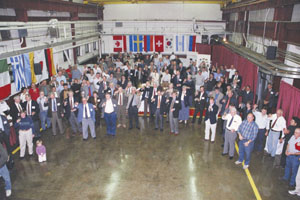In 1967, helped by Massachusetts congressman William H Bates, who was then on the US Joint Committee on Atomic Energy, MIT acquired a site for a new electron accelerator, which is still going strong. A recent symposium, held at MIT, marked 25 years of physics operation.

Some accelerators come and go; others come to stay. One of the stalwarts is the MIT-Bates electron linear accelerator. A symposium at MIT last November marked the 25th anniversary of the first publishable data on high-resolution electron scattering and photonuclear reactions at this remarkable machine.
Representatives from the Bates community and from universities and sister laboratories where electronuclear research is being undertaken took part. Speakers summarized where the field stands now, how it got there and where it might lead.
Talks from experimentalists covered the current state-of-the-art research at Bates and other laboratories, while theorists focused on some of the issues that arise in electroweak studies of nuclear and hadronic structure. The symposium aimed to underline the relationships between nuclear structure and electrons, the structure of few body nuclei, few-body nuclei/nucleon structure, hadronic structure and parity-violating electron scattering.
From the excitement conveyed in the talks, it is clear that each of these areas is receiving a lot of attention at all of the active laboratories and that the near future will continue to reflect intense activity. A notable feature at Bates has been the central position of the users, many of whom were present at the symposium, and in particular the enthusiasm and talent of generations of graduate students.
The decisive roles played by technological developments in the evolution of this field, and in particular at Bates, were highlighted.
In the earliest days, the development of dispersion-matching and energy-loss spectroscopy produced spectroscopic data with resolutions of better than 10-4 using the entire accelerator beam, the spectrum of which was spread over 10-2. In this era a group from the University of Massachusetts designed and built a magnetic chicane that extended the angular range to 180°, giving better access to magnetic transitions in complex nuclei.
Shortly after the pioneering experiments at SLAC in 1978 on parity violation in deep inelastic scattering, a Yale group proposed a similar experiment at Bates for which they designed and built a polarized electron injector. This ultimately produced a polarized electron beam of 60 mA and measured a parity-violating asymmetry in elastic scattering from carbon-12 of less than 1 ppm.
The success of spin physics

A succession of experiments using polarized electrons have followed, so that today most of the experimental programme uses spin-oriented electrons. Of note in the past few years have been the very successful data-taking runs on parity-violating electron scattering from hydrogen and deuterium (SAMPLE), the goal of which has been to determine the magnetic strangeness content of the nucleon.
Spin physics in general has been a growing theme at Bates. Quasielastic scattering from polarized helium-3 has been carried out on targets based on spin exchange with optically pumped rubidium (Harvard and Michigan) and/or optically pumped helium-3 with metastability exchange (Caltech).
Spin transfer and induced polarization have been studied in hydrogen and deuterium using either a proton polarimeter (Virginia, William & Mary, MIT) or a neutron polarimeter (Kent State). Tensor recoil polarization in elastic scattering off deuterons used polarimeters designed and built at Argonne, Alberta and Saclay.
These developments have been complemented by a challenging target development programme. Notable cryogenic targets were about 50l of tritium for elastic and quasielastic scattering (MIT and Saskatchewan), 50 bar of helium-3 at 24 K (Massachusetts) and a 40 cm liquid-hydrogen target dissipating 500 W of beam power (Caltech). Many of these projects have had implications that are continuing not only at Bates and other medium energy labs but also at SLAC, DESY (HERMES) and the Jefferson Laboratory.
Bates and the Out of Plane Spectrometer (OOPS) collaboration (Illinois, MIT, Arizona and Athens) have recently completed the construction of an array of four proton spectrometers that can be moved with great precision out of plane, which, when combined with polarized electrons, will provide access to electronuclear response functions that are otherwise difficult or impossible to obtain.
Commissioning and data-taking starts this spring and a time-stretcher ring will be used for part of this run to deliver high-duty factor extracted beams. In addition, looking to the near future and new initiatives, the lab is actively constructing a large acceptance detector (BLAST) to be used with polarized internal targets in the electron storage ring. Commissioning is expected in 2001 and the community is anticipating an exciting programme of nuclear/hadronic structure studies with electrons at Bates.
These and other technical developments provide a powerful handle on the electronuclear S matrix. Experimental work has just begun on a selection of the more promising observables, and some important new results were presented at the symposium, with many more expected in the near future.
The symposium proceedings will soon be published by the American Institute of Physics.








